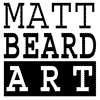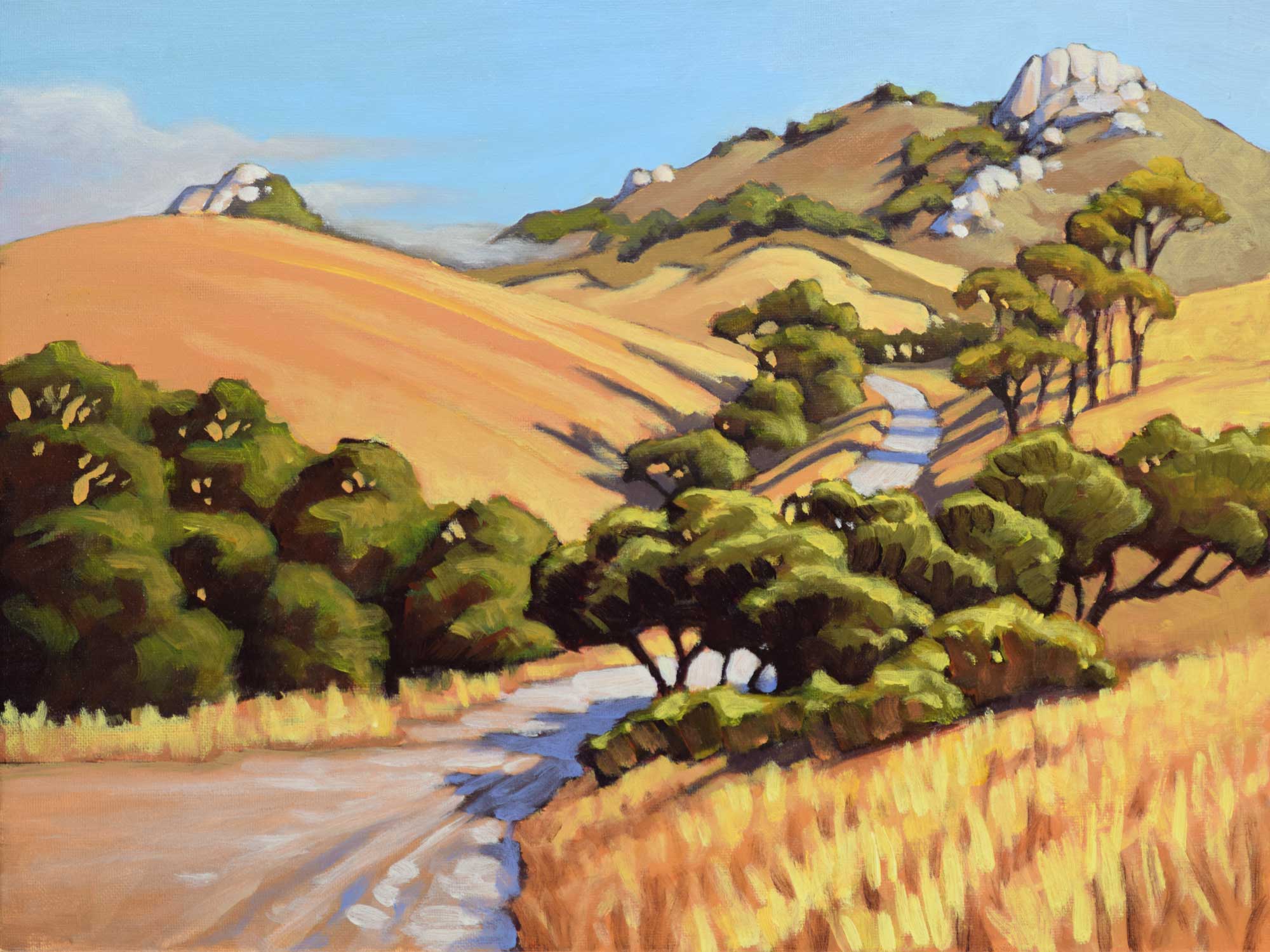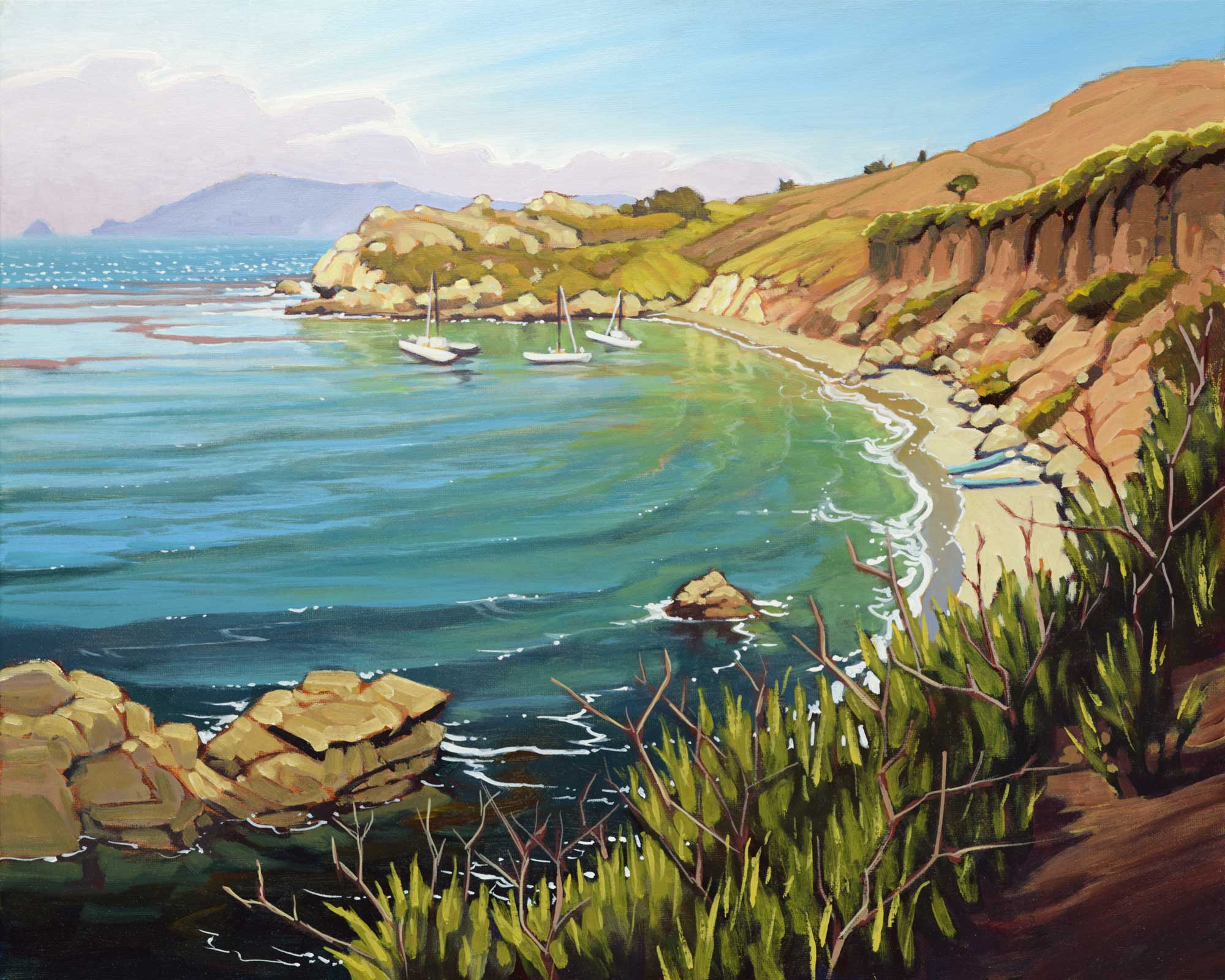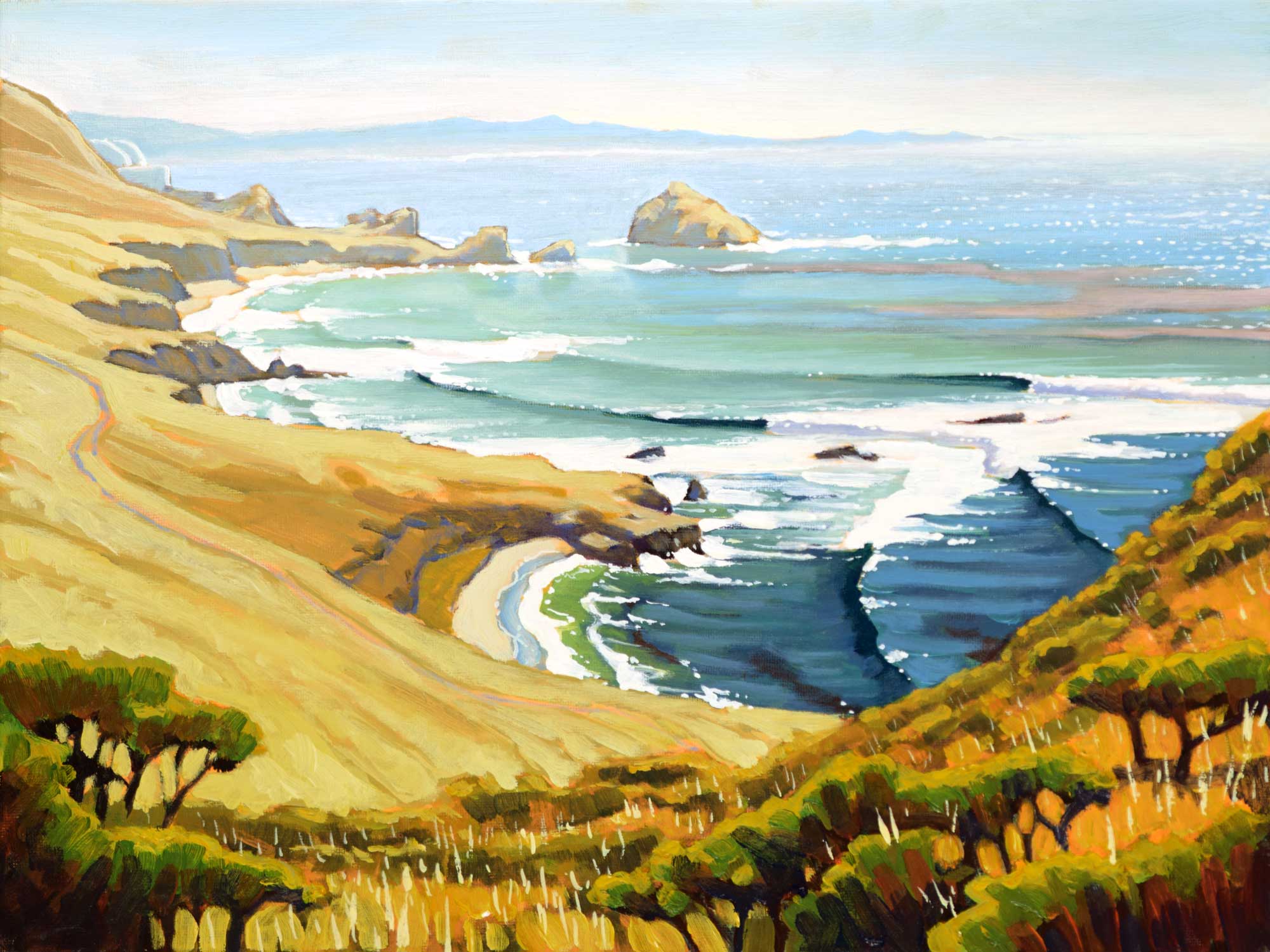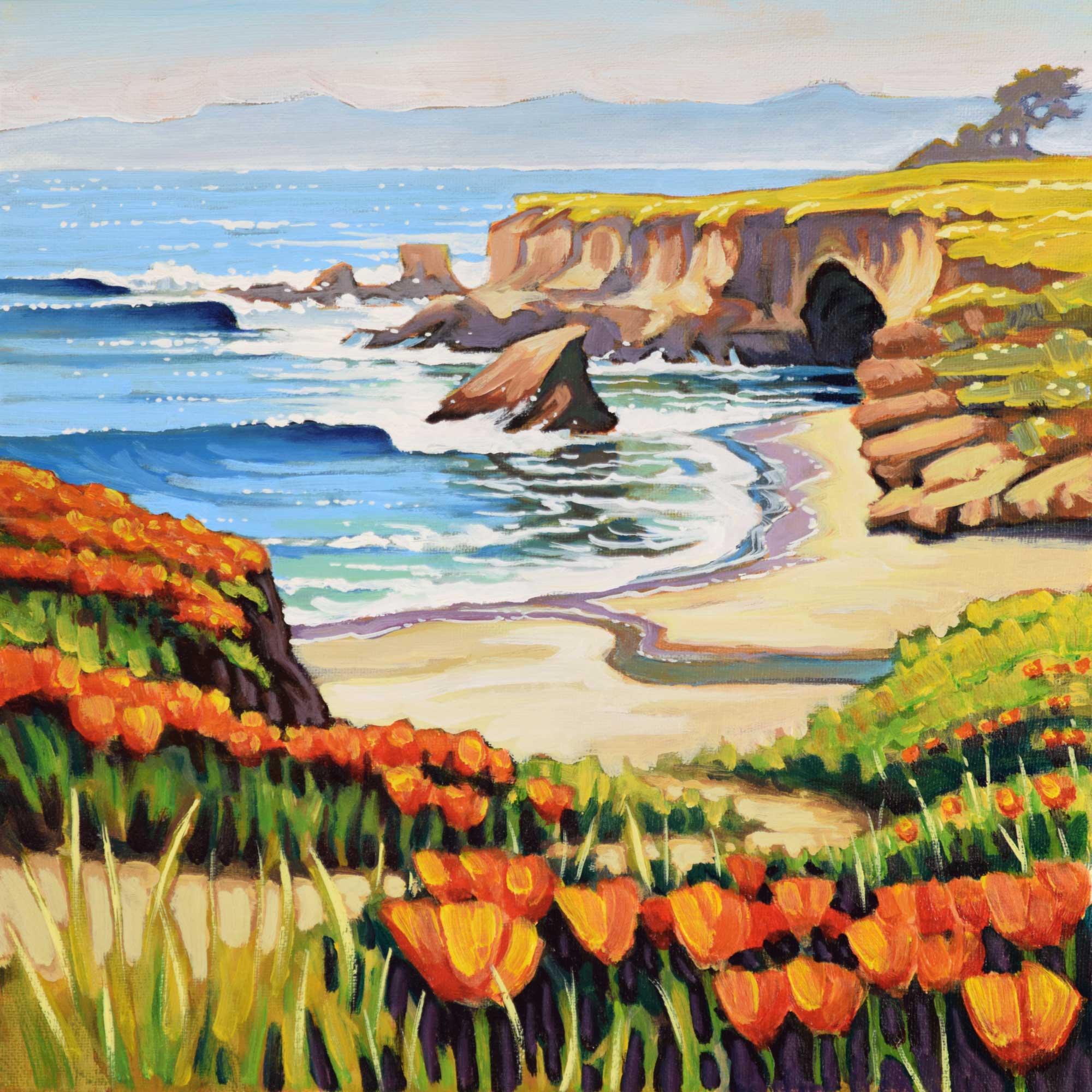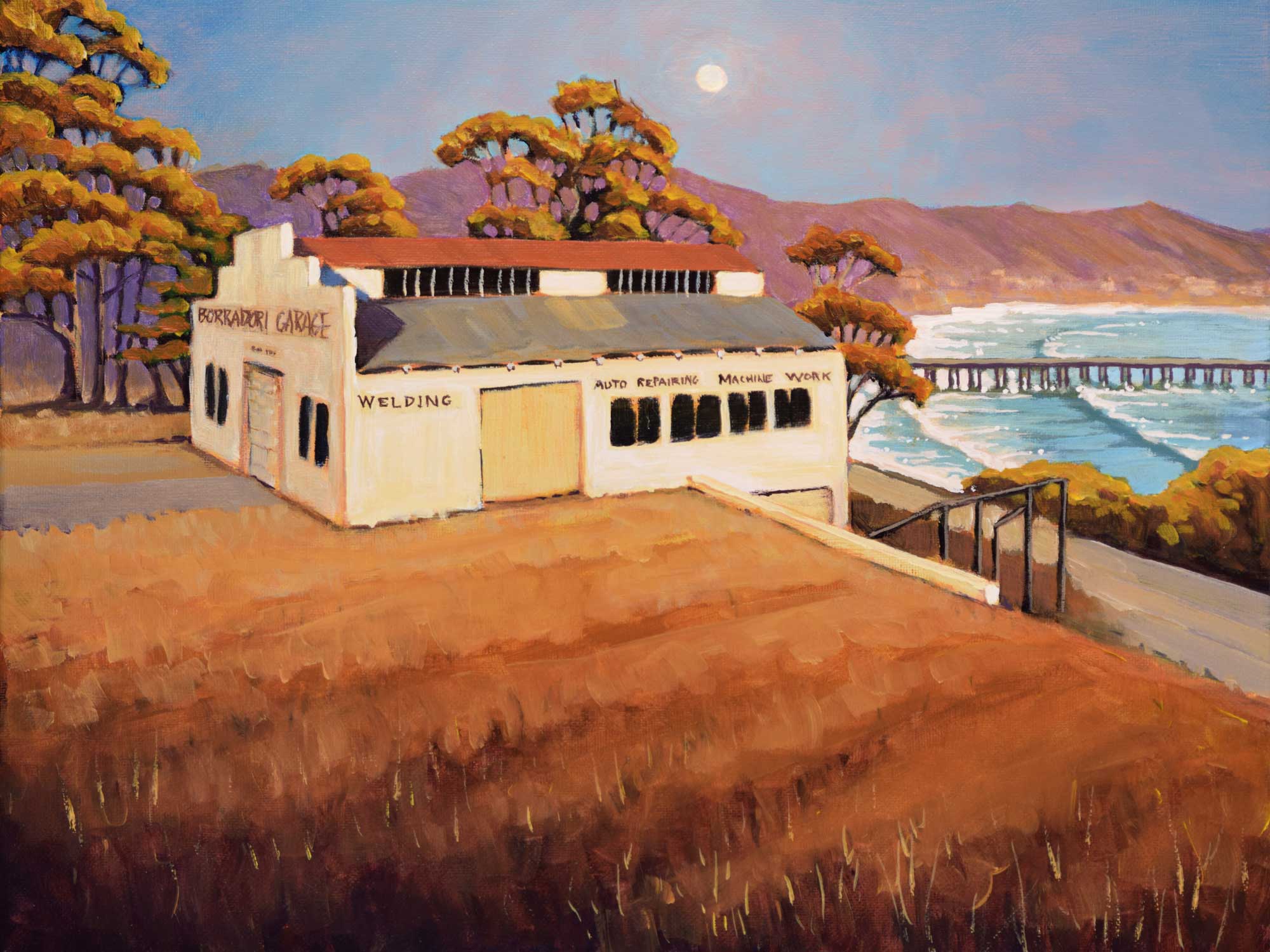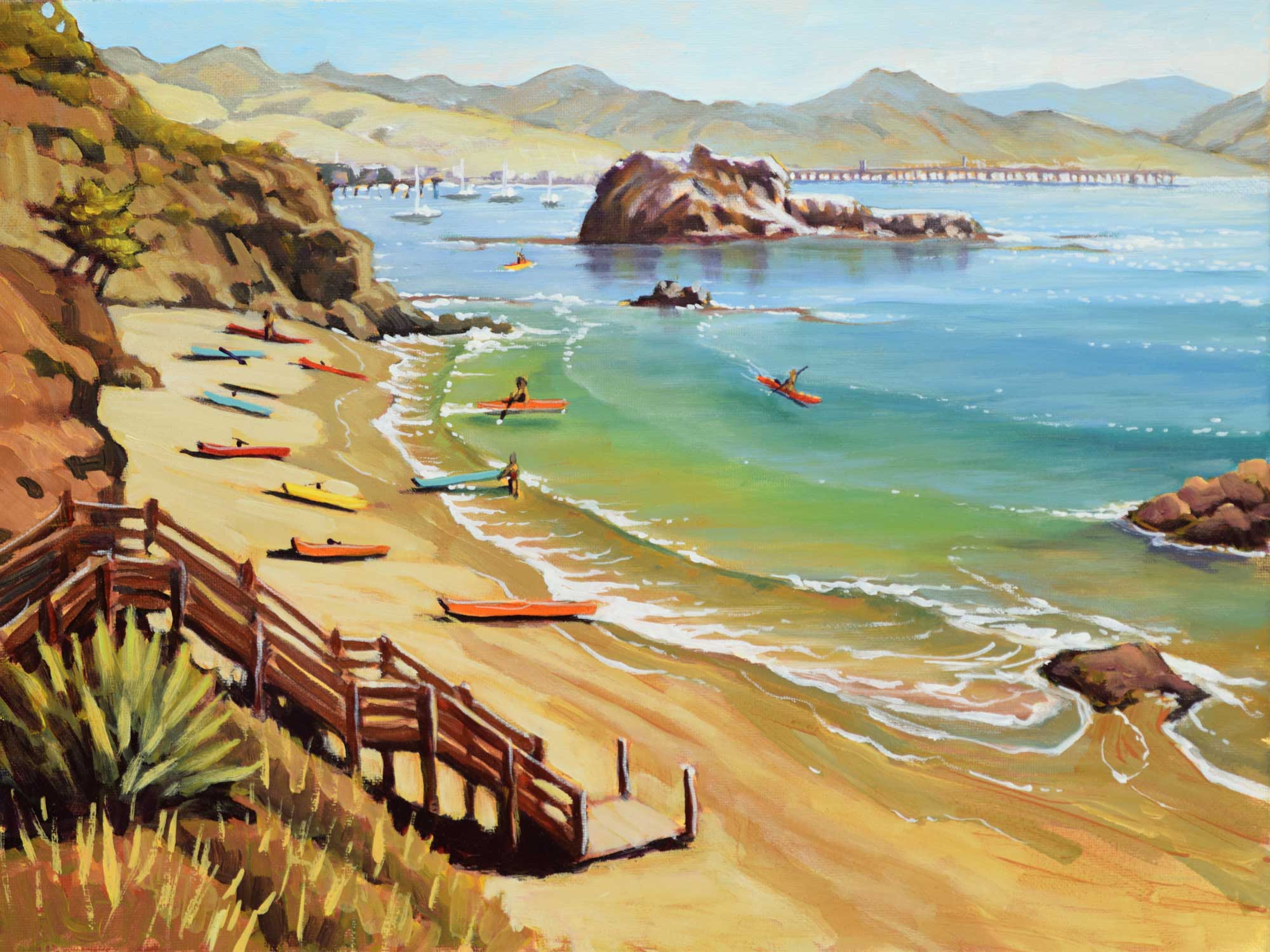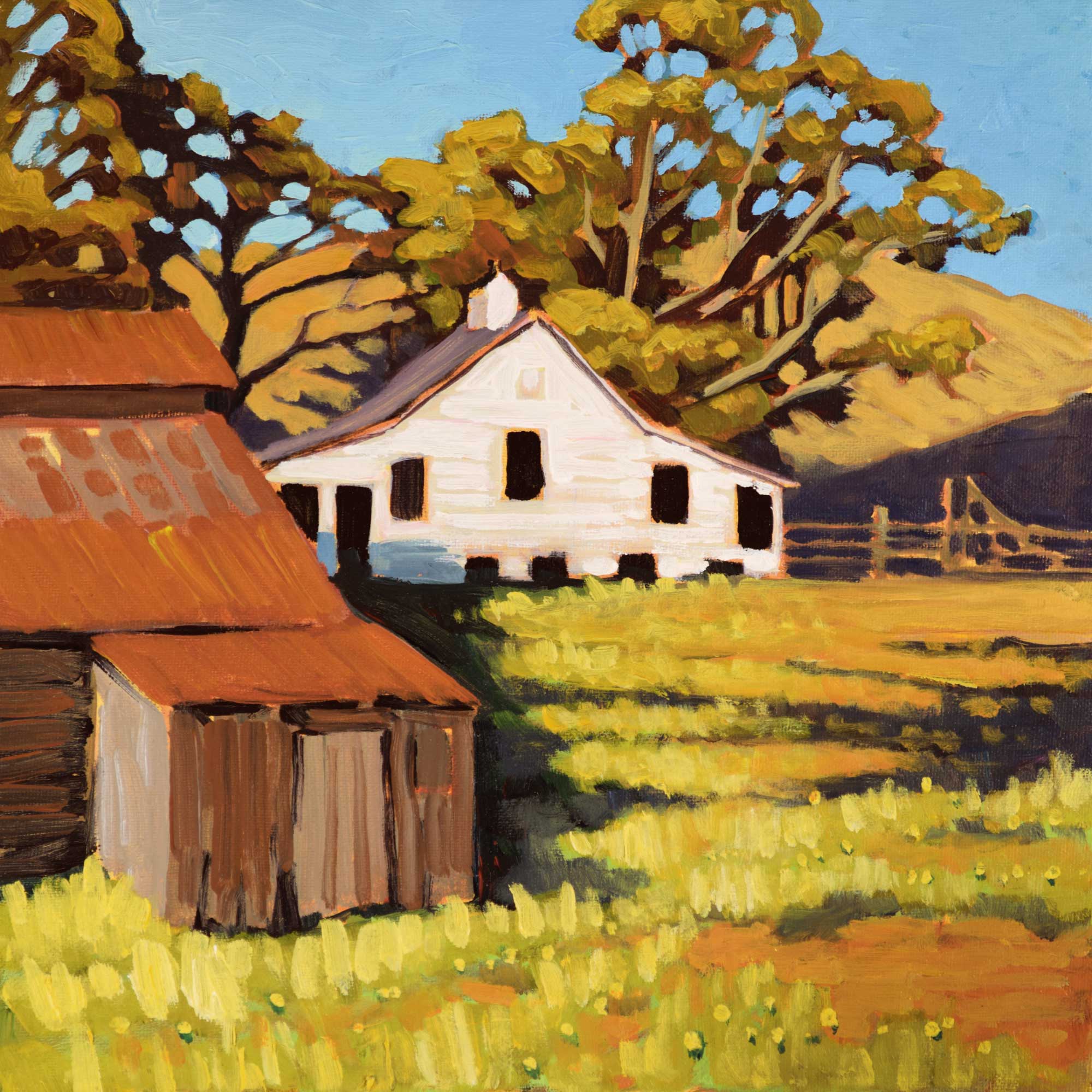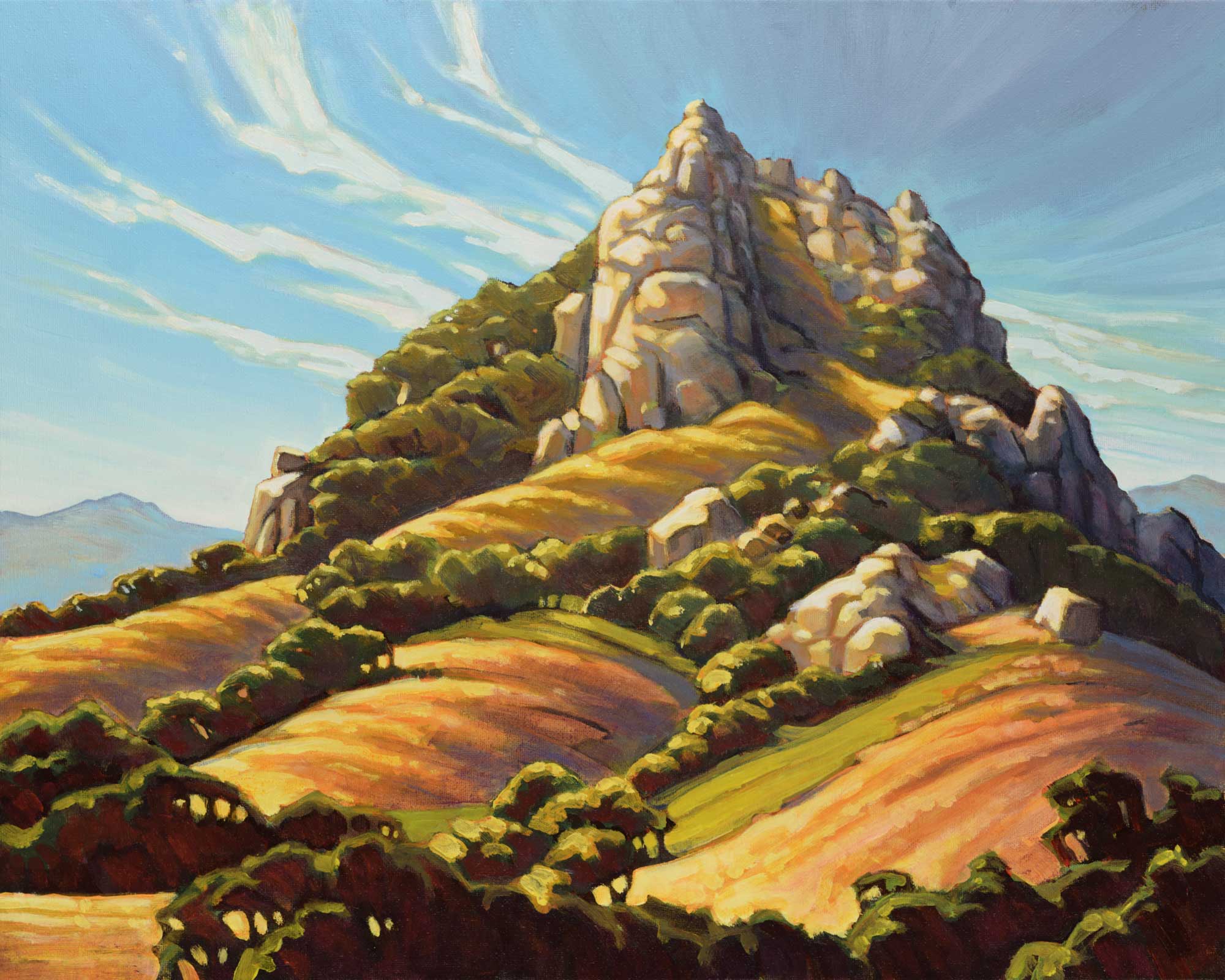Backstories, Backroads, and No Roads at All
5 days in San Luis Obispo County. 11 Paintings. 16 miles hiked. 2 miles paddled. 1 barbed wire fence. 1 mountain, painted twice... by accident.
Enjoy...
I. A Dissonant End
I've got no ear for harmonies, seriously. I might not be tone-deaf, but I am certainly tone-dumb. But I have heard that in the language of jazz, the end of a song is often signaled by a dissonant chord. I couldn't really pick a dissonant chord out of a crowd, but I understand it to be one that isn't in tonal harmony, whatever that may mean. It doesn't quite fit in, it's jarring, and out of place. But it works I guess.
The end of this trail was kinda like that for me. An abrupt end at a barbed wire fence plastered with signs warning the would-be trespasser (me) to go no further. Of course I had wanted to go further, that was the plan all along. A quick lunch break while assessing the feasibility of proceeding would see a ranch truck come and go and come again in the span of about 20 minutes. Nuts. I could be wrong, but I was sure I saw some beady-eyed stink-eye being cast my way as well. I think these guys can smell it on me sometimes.
So I figured I'd buy some time and just paint this little vista safely on the public side of the fence then see if things might quiet down. And they sorta did, but the ranch truck guy hadn't left yet, so I figured it best to hop along the cliff edge out of view of the road. I made my way quite a good distance up the coast this way until two things happened. First, I reached an impasse where I could go no further without heading up toward the road and all the risks it would bring. And second, while pondering my predicament, the fog bank finally rolled in and made my decision for me. No point going further if there was nothing to see, so I turned back and called it a day. This place just didn't fit in with my plans for the day, but such is life on the coast.
The hard to reach places are just that, and that's what makes them so special to finally reach when everything lines up, and that works fine for me.
II. The Back Road
Again, thwarted by fog on the coast, I found myself scouring the hillsides and back roads on this otherwise bright and clear morning for something to paint. Once I'm off the coast I get a little bewildered and find inspiration an often fleeting thing. But I was here to paint so I kept on and this little ranch road caught my eye leading up toward one of the rocky peaks that dot the landscape.
I didn't realize it at the time but this would be a significant piece to kick off this tour of the area, the peak itself being one of the most personally meaningful locations I'd paint on this trip- hallowed ground for sure. But that's a story for later on...
III. Sir Francis Drake was a Pirate
It's true, he was. The Spanish navy hated the guy. But that's history. And according to some amateur historians it is believed he may have hidden treasure in the caves on the headland at the end of this cove. Joined by my friend Wade Koniakowsky, we were stoked to walk up to this scene on a crisp sunny morning after the days of fog I'd been battling previously. We thought that was like walking up and discovering treasure.
Finding the beach below empty was a great discovery as well, especially since it's a notorious nude beach. Empty was just fine for us, thanks. Did you know they call the creepers on the cliffs "scalleywags" or "rock monkeys"? They have so many folks creeping up to oggle the nudies that they have names for them. I don't know if that's true, I read in a paper once though. Could be fake news, who knows these days?
But what we do know is that even if those caves weren't used for Drake's treasure, they were at least used for smuggling moonshine during the prohibition years. The smugglers even carved steps into the rock face out at the end of the point to help run the rum up and down coast. Oh, and Francis Drake was a pirate. We know that too.
IV. Ebb and Flow
There is nothing like painting in the cool shade on a warm summer day, with a good pal like Wade Koniakowsky humming around and returning with snacks and cold beers.
In spite of taking the time to go foraging for our sustenance, I think he still completed two paintings here while I stood there plucking away at bits and pieces of this one while watching the afternoon low tide ebb, then turn to flow back in again.
V. The Devil at my Heels
Considering the miracle of his survival and his boldness to share his faith in God, one could make an argument in favor of nominating Louis Zamperini (the author of book The Devil at my Heels) for sainthood, or at least make him a bishop or something. It's quite a story and well worth reading, but aside from some overt wordplay subterfuge, it's not the story of this painting.
The devil that was at my heels this day, wasn't a devil at all. But he worked for one, or at least a nuclear power plant that has taken the devil for its name. I'd hiked the 3 or 4 miles out on this windy day to see the furthest reach of this coast that I could legally access. It's not public land, but is open during limited hours for public use with strict regulations about staying on the trail. These situations can make my work difficult. The best views are often a bit off the beaten path. I'd have to settle for a trailside setup today and was fortunate to find a spot that featured both the only view of the power plant itself from the legal trail system, and a nice windblock from the hill behind it. Painting here was a no brainer.
After completing this, I hiked the rest of the allowable distance on the trail to it's end, always followed by a white truck. I'd walk around a bend, and he'd pull up to a lookout on the road above the trail. Everywhere I went. For the next 2 hours. There were points where the road was right beside the trail, but he'd never stop there to chat. He'd go on a head to another lookout and wait for me to pass. His watchful eyes and lack of interaction had me wanting to mess with him and wait for him to go just out of view, then turnaround and backtrack and wait for him to follow, then do it again and again until he gave up or finally approached me.
But I was tired (my outdoor studio travels well, but it's not the lightest pack in the world), and if I hurried at a good clip I'd have time to paint another little painting before being locked behind the closed gate. I'd already scoped a perfect patch of poppies over a beach with a flowing creek, so there would be no fun and games today, just a mad hike into the howling wind with the devil at my heels.
VI. Red and Gold
Corralina, it's the Italian word for coral, and though no coral is found in this cold water, there is a red seaweed with a hard calcerous surface named corralina that does grow in the rugged tidepools. There's also poppies that bloom in the spring here. I had a strict 25 minutes to paint this one before getting locked in for the night with the devil in the white truck. Not an option, so I worked fast, got what I needed done, then did a bit of work at home later to bring it through.
VII. La Meccanica in un Momento di Pace
High tariffs in the newfound Kingdom of Italy in 1865 led to a large number of dairy farming Swiss-Italians to come to the US and eventually settle around this town. This coincided with the massive droughts that had just collapsed the large cattle ranches that dominated the California coastal landscape until that point.
After the drought, small dairy farms became a viable reality and by 1880, Italian was the dominant language in this small town. And to this day the Italian influence can still be seen with icons like the Borradori Garage standing watch over the pier that was built to facilitate shipping of the local dairy products.
It's a peaceful setting, not at all what today's prominent Borradori namesake, philosopher Giovanna Borradori writes about in her volume Philosophy in a Time of Terror. The title of this painting, La Meccanica in un Momento di Pace, is Italian for Mechanics in a Time of Peace, an inverted nod to both Borradori's. What is more opposite of terror, than peace? What is more more opposite from philosophy than mechanical repair? Maybe that one's not as obvious as the first, but I'm sure a case could certainly be made* over a beer or two while standing on top of my van in the soft summer evening light.
*Full disclosure: I hold a minor degree in philosophy so standing around on an incredibly useful mechanical vehicle while arguing about incredibly useless subjects is something I consider not only good sport, but also an art. Cheers.
IX. Meet Me in St. Louis
My friend Colleen Gnos is a great artist. You might want to check out her work sometime. She studied in Italy. There may be a theme developing here, but I'll save that for another day.
In the meantime it's enough to let you know this painting could not have happened without Colleen. She generously agreed to provide kayaks and paddleboards and accompany Wade and I on a one-mile paddle to paint this beach that is generally only accessible by water.
If you're up to speed on your 1940's film history (and I'm not) you might get the subtle references going on with this title- the family that is the subject of the film Meet Me in St. Louis shares the same name as the family that once built houses for themselves out on that small rock island just off the shore here. It doesn't hurt that the whole area is named after another Saint by the same name as well. Offbeat and obscure coincidental poetry for sure.
Back to this day, though- any day that involves hauling paint gear and returning with an artifact from the edge of a place that few painters would bother to venture with easels and paints is a good day in my book.
Thanks Colleen!
VIII. A Pier Then Disappear
Back to the Italian dairy farms that took root here in 1860's... I painted this small dairy farm building one afternoon from beside an old ranch house where a not-so-Italian friend of Wade's was living.
Another not-so-Italian fellow had long ago purchased this land and setup operations here back in 1867. He first lived in the small ranch house set in this picturesque valley, and began overseeing the dairy operations behind the house with a mind toward something bigger than the dairy. A former ship captain himself, his interest was in shipping and commerce and not long after settling here, he built the town's pier straight down from this dairy (along with a fancy new house right beside the pier that still stands today as a landmark that leaves the small ranch house and its dairy in its historical shadow).
You can't see the ocean or the pier from here anymore, the new coast highway has been laid on an embankment built across the valley, separating the coast from this small dairy farm that has long since ceased dairy operations altogether. But their pasts are inextricably linked together. The isolation provided by the highway severing this ranch from the small town has also helped to preserve this piece of history.
On this bright summer afternoon I couldn't resist attempting to tell its story. I'm sure I botched parts of it, but I tried to keep it straight.
X. Grounded
I painted this boat over a year ago, grounded hopelessly on the rocks here after learning that it had previously belonged to my friend Colleen Gnos's grandfather for years. It was even named after her brother until it was sold and the new owner gave it a new name and ran it aground in short order.
This is where it's been since. Except it's spun around 180 degrees. It'll eventually break into pieces here, but not for awhile. Part of the landscape now.
I wanted to revisit it. It's a great reminder that no boat stays at sea forever, and for each of us our day will come sooner or later, and often unexpectedly.
XI. Hallowed Ground
William Wendt is widely considered one of the founding fathers of California Impressionism, a distinct school of impressionist art forged in the California landscape back in the early 1900's. One of Wendt's most iconic paintings is called What Nature's God Hath Wrought and features a boldly centralized view of this very peak.
Wade and I spent an afternoon scouting the countryside, climbing under fences, walking through high grass, fumbling our way around holding pictures of Wendt's masterful painting up to the mountain before us, comparing views to determine roughly right where he stood and painted the scene from. We pretty much nailed it down one afternoon and decided to come back to paint it ourselves in the morning light. Too be honest, I wouldn't have bothered if it wasn't for Wade. The whole ocean thing. Hard to motivate. All that.
But once we got going I was hooked. And also blown away all over again at Wendt's masterful work. It's just some rocks sticking out of the ground, but he gave them majesty. I kept thinking his composition with that mountain smack in the middle of the canvas just shouldn't work, and yet it does. Neither Wade nor I were trying recreate Wendt's painting- we didn't even look at it once we had the spot figured out, our goal was just to stand where he stood and respond to the scene before us like we would with any other painting. I can't speak for Wade, but I'm pretty sure neither of us felt like we had done half a lick of justice to the scene as the morning wound into afternoon and hunger took over. But still, we'd walked on hallowed ground.
It wasn't until I looked closely at a map later that I realized that the painting from earlier in the trip is actually the back side of this very same peak.
Kinda funny that I painted this one twice and if it weren't for Wade and the fog I wouldn't have painted it all.
